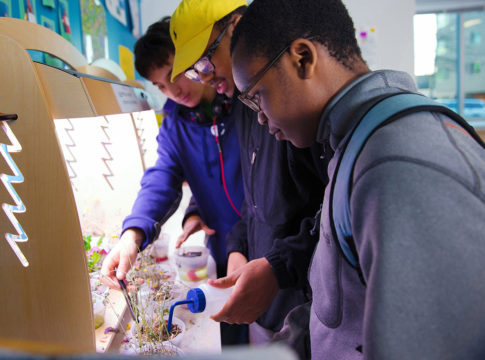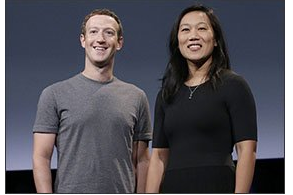Dear Mark and Priscilla,
 Please allow an aging education reformer to offer some unsolicited advice regarding the work of the new Chan Zuckerberg Initiative.
Please allow an aging education reformer to offer some unsolicited advice regarding the work of the new Chan Zuckerberg Initiative.
Almost 20 years ago, I wrote a long public letter to Bill Gates that drew lessons from earlier philanthropic efforts in K-12 education—including many billions of dollars wasted by the likes of Ford, Rockefeller, and Annenberg. In it, I offered suggestions for the most useful work that the then-new Bill & Melinda Gates Foundation might do in this realm, particularly by advancing the (also new) concept of charter schools.
In fact, Gates has done—and continues to do—good work in the charter sector. Much of what his foundation has undertaken in the K–12 realm, however, has fallen prey to the classic temptation to try to reform school districts. You—Mark—apparently succumbed to that same temptation when you committed $100 million to the renewal of public education in Newark, by way of both district and charter schools. Smart fellow that you are, you’ve acknowledged that the charter part of this generous gift has done some good (whereas the district part, not so much). You’ve probably read Dale Russakoff’s excellent book about what went wrong in Newark; she notes that you and then-Mayor Cory Booker intended “not [just] to repair education in Newark but to develop a model for saving it in all of urban America.” That obviously didn’t happen. Russakoff says the legacy of that ambitious effort includes as much rancor as reform in New Jersey’s largest city. The district’s new superintendent, Chris Cerf, is trying to bring people back together (see “Continuing Change in Newark,” features, Fall 2016).
The lessons are broader than charter versus district, of course. They primarily concern the fundamental complexity of turning around the behemoth of public education, as well as the amount of time, sophistication, multitasking, and sustained effort that’s needed to cause it to deviate even a little from its traditional course. It’s also important to keep in mind that, as the University of Arkansas’s Jay Greene has repeatedly noted, philanthropy is a drop in public education’s huge fiscal bucket. It’s often possible for a sizable donor to get the K–12 system in a particular place to add some program, project, or activity that the philanthropist is willing to pay for (with such additions generally lasting as long as the checks keep coming). But causing a district or state—even a single school—to alter its accustomed ways to any significant degree over the long haul takes more leverage than philanthropy can muster.
Sure, there are rare places—maybe just enough of them to keep reform-minded philanthropists doggedly trying to find more—where the stars align and the leadership is in place to make a change that donor and the local superintendent can agree on. Michelle Rhee and Kaya Henderson, aided by millions of private dollars, were able to institute epic reforms in both teacher evaluations and compensation in the District of Columbia Public Schools. With similar assistance, Michael Bennet and Tom Boasberg began to turn the Denver Public Schools into the country’s most advanced “portfolio” district (see “Denver Expands Choice and Charters,” features, Summer 2016). See, too, what Joel Klein accomplished (with Mayor Michael Bloomberg’s backing as well as philanthropic aid) in New York City. But as the example of that city (on Mayor Bill de Blasio’s watch) vividly displays, such changes can prove ephemeral if a school leader or philanthropist loses interest—or if the reforms they launched are undone by an election or board upheaval.
Much the same is true of education’s other large institutions, most famously the colleges of education that train our K–12 teachers and principals. They are (again, with rare exceptions) about as immune to fundamental change as mountains and glaciers. (Where is climate change when we need it?)
If a philanthropist wants simply to “do good” in the education space, none of this matters. It’s a no-brainer to underwrite a building, a professorship, a scholarship, a summer program, a lecture series, a roomful of laptops, a field trip, or a gala recognition dinner. You can get thanked, praised, photographed, tweeted about, or liked on Facebook. (Yes, Mark, you created that opportunity, and many thank you for it.) All those sorts of things are easy and generally without controversy, much less rancor.
The challenge arises when, rather than adding to or celebrating the existing K-12 system, you try to advance major-league reforms in it. Whether your sights are set on more rigorous academic standards, foolproof reading instruction, greater teacher effectiveness, expanded school choice, overhauled governance, or almost anything else that would benefit from big-time change, the challenge is huge. Save for the rare and exceptional situations noted above, you’ll be trying to move a mountain. You won’t have enough leverage, and even if you shift it a little, it’ll settle back down as soon as you stop pushing.
I understand the temptation to move the mountain. As has been said a thousand times, the overwhelming majority of kids, including the overwhelming majority of needy kids, attend district-operated schools; if we don’t do something about those district schools, the great majority of kids will be left in the dirt. I get it. It’s even true. And that’s why policymakers and elected officials at every level—national, state, local, even international (think of the OECD)—have struggled for decades to reform and revitalize the district-based public education system. And struggle they should. This is among the most difficult jobs they face, and when they seek your help with philanthropic dollars, you should listen closely.
Your Greatest Asset
That does not, however, mean you must do what they ask. Philanthropy is not government, and it forfeits its distinctive advantages when it cozies up to government—even more so when it does government’s bidding.
One of the biggest mistakes some major foundations have made in the education space has been adding their dollars, and whatever legitimacy they bring, to government initiatives. The most vivid example has been the Obama Education Department’s Investing in Innovation Fund, which requires grant recipients to come up with matching dollars from the private sector (that is, private philanthropy). A dozen major foundations committed half a billion dollars to this program, dollars that were then bent to the government’s priorities and project selections. I know, I know: My friend Jim Shelton, who ran that program for the government, now runs Chan Zuckerberg for you, and I’m sure he disagrees with me. But I have to say it again: Government and philanthropy ought to cherish their differences and sleep in separate beds.
Especially considering how puny philanthropy is next to government, its greatest asset isn’t money—it’s independence, the singular ability to do things that government cannot or will not do. Occasionally, that means piloting something that, if successful, government may then do more of. This is itself risky, as it may force philanthropy to confine its reach and vision to work that’s politically realistic for government to undertake. But it’s not as risky as letting government call the shots and determine which initiatives and projects are worthy of support.
So please don’t do that at Chan Zuckerberg. Please badger Jim not to do it. Please don’t let either the constraints or the priorities of government shape what you do in K–12 education.
A smart new book by Megan Tompkins-Stange unpacks some of the tension and confusion we see in philanthropy’s stance toward government. It recaps the major differences between philanthropy and government, beginning with a useful distinction between two “different worldviews about the role of foundations in a liberal democracy.” The “outcome-oriented approach, which primarily values the attainment of effective policy outcomes,” leads foundations to “act as effective, efficient problem solvers that can circumvent bureaucratic blockages and catalyze innovation.” In other words, they go it alone, abjure government, and do things it can’t or won’t do, even when that may mean “privileging the views of elites.” Alternatively, the “field-oriented approach…primarily values the democratic engagement of citizens” and leads philanthropists to function as “vehicles to foster citizenship and mobilize broad political participation”—including participation in government itself.
The tension between these two strategies, Tompkins-Stange explains, “is rooted in the double-edged sword of foundation accountability to the public. On the one hand, foundations are fundamentally private organizations that influence policy priorities outside formal democratic deliberations—a critique that has generated concerns about plutocracy. On the other hand, foundations may benefit democracy as an efficacious alternative to the bureaucratic state.”
There’s a big choice to be made here. Will Chan Zuckerberg be a pilot fish—a brain trust, prod, and fount of matching dollars—for government? Or will it function as an autonomous actor that does very different things? These would include tackling challenges of policy and practice that engage the government but that no politician is brave enough to touch. Here’s an example: America’s forty-year-old approach to educating disabled students needs a thorough makeover, but nobody in government will go near the topic. And to the best of my knowledge, no foundation has the guts to support those outside government who might tackle it if resources were available. One sound reason for you to consider doing so is that the “individual education plans” (IEPs) mandated under special education are, arguably, a clumsy early version of the “personalized learning” that you—and I—believe should become ubiquitous.
Mostly, though, just avoid government entirely. That means not following in the footsteps of funders like Bill Gates and Eli Broad, whose foundations have enthusiastically teamed up with government, done its bidding when it wasn’t doing theirs, and traded key staffers back and forth.
That you are willing to deviate from conventional philanthropic practices is evident in your decision to make Chan Zuckerberg a limited liability corporation (LLC) rather than a private foundation like Gates, Broad, and legacy players like Ford, Carnegie, Packard, and MacArthur. The LLC structure enables you to invest in for-profit ventures, startups, and political activities in ways that government (and traditional foundations) cannot go near. That’s a huge advantage—provided, of course, that you use it well.
As you can see, I’m urging you to use your independence, flexibility, and assets (sizable as they are in philanthropic terms even if meager alongside America’s K–12 education budget) to press for change outside the district structure. You should create and replicate institutions, programs, and activities that the established structures of American public education can’t or won’t go near. And you should stick with them long enough that they—provided they’re successful—get some traction and some hope of longevity.
Think Outside the Box
That doesn’t mean the initiative always needs to come from your end. Practitioners of what’s now called “venture” or “strategic philanthropy” have been carried away by the conceit that they know best what needs to happen, and they often confine their support to those who take direction from them. Be a little more humble here. There’s much to be said for an older philanthropic tradition in which the donor waits to be approached by someone who might have a plan, a project, or an idea with merit that never would have occurred to the people with money to give.
What sorts of things am I suggesting? Charter schools are still a fine example, as I wrote to Bill Gates back in 1998. But don’t limit yourselves to charters for inner-city residents. Those are much needed, and the best of them are life-changing and deserve to be replicated. But “chartering” is a more flexible and capacious concept; it can be deployed to advance the education of kids with all sorts of different needs, interests, and possibilities. Why don’t you declare Chan Zuckerberg open and receptive to educators and entrepreneurs who are keen to explore those boundaries?
Likewise with alternative pathways into education. There are great outfits today (examples include Teach For America, the Relay Graduate School of Education, New Leaders for New Schools, and the Broad Fellows program) that assist talented individuals who want to work in education to gain entry—as teachers, principals, leaders, and so on—without requiring them to pass through all the traditional certification hoops. But they’re Lilliputian when compared to a K–12 enterprise that employs close to four million teachers, a hundred thousand principals, and any number of others. Much more is needed on this front.
High-class technology with solid content for use in “blended learning” settings is a no-brainer for you, and it holds great potential for the future. Indeed, a serious push to personalize kids’ education hinges on far more adept use of both hardware and software than anyone is now making. By all means, encourage further development on this front. But there’s so much more that needs to be done. Thinking a little farther outside the usual K–12 philanthropic box: We’ve recently seen a raft of rigorous new academic standards and better tests, all of them said to be aimed at making every student “college- and career-ready.” But most kids haven’t a clue whether they’re truly “on track” for such a future; indeed, millions of today’s young people will be sent into remedial courses on campus because their K–12 education did not prepare them to succeed there. Even those who may be on track for something after high school don’t know what their K-12 experience is preparing them for—Princeton, the local community college, a state college, a truck-driving school, or whatever else.
The truth is that scads of students are destined to have their hopes dashed after graduating from high school. The fact that they don’t discover this until then is an outrage. It also fosters false complacency (and misleads their parents) while they’re in school. Yet those who run and teach in the schools aren’t about to solve this problem because it’s not in their interest to be the voice of unwelcome truth. So it must be done from outside. Through technology and social media, you could find ways to raise awareness among kids that they are not on track for success. Then, help them understand what to do about it.
There’s truth in the lament, voiced from both left and right, that American society is separating into haves and have-nots; the prospects of upward mobility are dimming both for the poorest and for those in what we’ve traditionally called the “working class.” This problem is deeply entangled with flaws in our education system, but it isn’t likely to be solved by that system. Part of what needs to happen is a flowering of much better opportunities—in school and out—for high-ability poor and working-class kids with obvious potential to be upwardly mobile. Unfortunately, few of them have the pushy parents or attend the posh schools that try to be serious about “gifted” education. They need scholarships to go to other schools, supplemental learning opportunities, and the kinds of great summer programs (such as those under the umbrella of Johns Hopkins’s Center for Talented Youth) that aggressive upper-middle-class parents arrange for their bright daughters and sons. And while you’re at it, how about developing robots that can play the mentoring and advising role that those aggressive parents play? (A too-cute robot might even be an improvement!) You could also advocate for “Enrichment Savings Accounts” to help narrow the extracurricular-opportunities gap.
Another route to upward mobility—one that does not rely on exceptional personal gifts other than determination and grit—is through career paths that run through top-notch technical education, apprenticeship programs, and the like. Think, for example, about all the non-physician roles in health care that call for sophisticated preparation but—other than tradition and perhaps status creep—don’t really need a college degree. What they require is demonstrated evidence of exceptional prowess, which can be acquired in many different settings. Here, too, Chan Zuckerberg could make a huge contribution.
Mark, you have already brought something wholly new into the world: a new medium for sharing, connecting, consuming, and advocating that represents one of the greatest creative accomplishments in recent history (cat videos aside). You didn’t set out to “tweak” or “improve” or even “change” the system that existed. You set about to invent something no one had ever imagined.
Bring that spirit into education. Focus not on the system but on innovators—in the charter movement and beyond—who are also creating something wholly new. And tell Jim Shelton: This is finally his chance to support breakthroughs in K–12 schooling that the government, even when “investing in innovation,” is too risk-adverse to touch.
Thanks for your attention, and best wishes for your daughter Max in preschool.
Sincerely,
Chester E. Finn, Jr.
Chester E. Finn, Jr. is distinguished senior fellow and president emeritus at the Thomas B. Fordham Institute.





